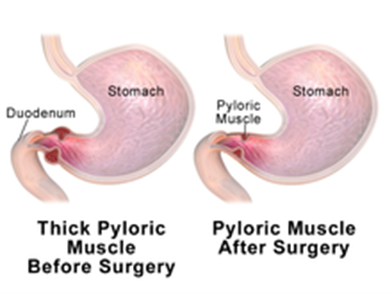A 6-week-old infant with poor weight gain is scheduled for a pyloromyotomy. Which pre-operative nursing action has the highest priority?
Mark an outline of the "olive-shaped" mass in the right epigastric area.
Maintain a continuous infusion of IV fluids per prescription.
Monitor amount of intake and infant's response to feedings.
Instruct parents regarding care of the incisional area.
The Correct Answer is B
Choice A reason: Marking an outline of the "olive-shaped" mass in the right epigastric area is not a priority nursing action. The mass is caused by hypertrophy of the pyloric sphincter, which obstructs gastric emptying and causes projectile vomiting. The mass may not be palpable in all cases.
Choice C reason: Monitoring amount of intake and infant's response to feedings is important, but not the highest priority. The infant may have difficulty feeding due to nausea, vomiting, and abdominal pain.
Choice D reason: Instructing parents regarding care of the incisional area is a post-operative nursing action, not a pre-operative one. The parents will need to learn how to keep the incision clean and dry, monitor for signs of infection, and administer pain medication as prescribed.

Nursing Test Bank
Naxlex Comprehensive Predictor Exams
Related Questions
Correct Answer is C
Explanation
Choice A: Measuring urine output daily is not a specific statement for the nurse to include, as this is a general recommendation for all clients with urinary catheters and does not address the potential complications of a suprapubic catheter. This is a distractor choice.
Choice B: Observing urine color and clarity is not a relevant statement for the nurse to include, as this does not reflect the condition of the suprapubic catheter or its insertion site. This is another distractor choice.
Choice C: Inspecting genital area for signs of infection is an important statement for the nurse to include, as this can help detect and prevent urinary tract infection, peritonitis, or abscess formation, which are common risks associated with suprapubic catheters. Therefore, this is the correct choice.
Choice D: Palpating flank area for tenderness is not a necessary statement for the nurse to include, as this is not an accurate or reliable method to assess for kidney function or damage, which are unlikely to occur with a suprapubic catheter. This is another distractor choice.
Correct Answer is C
Explanation
Choice B This situation could lead to conflict, but the client is not actively posing an immediate danger. The nurse should still intervene, but it is not the highest priority.
Choice A is incorrect because the client with anorexia nervosa who is refusing to eat the evening snack is not in immediate danger. The nurse should monitor the client's nutritional status and weight, but this can be done later.
Choice C iThe client with bipolar disorder who is pacing may be exhibiting signs of agitation, restlessness, or escalating mania, which can quickly lead to aggression, impulsivity, or loss of control. This behavior requires immediate attention to ensure safety for both the client and others on the unit. Manic or agitated patients may become unpredictable, making early intervention crucial.
Choice D is incorrect because the client with major depression who refuses to participate in group is not in immediate danger. The nurse should encourage the client to join the group, but this can be done later.
Whether you are a student looking to ace your exams or a practicing nurse seeking to enhance your expertise , our nursing education contents will empower you with the confidence and competence to make a difference in the lives of patients and become a respected leader in the healthcare field.
Visit Naxlex, invest in your future and unlock endless possibilities with our unparalleled nursing education contents today
Report Wrong Answer on the Current Question
Do you disagree with the answer? If yes, what is your expected answer? Explain.
Kindly be descriptive with the issue you are facing.
